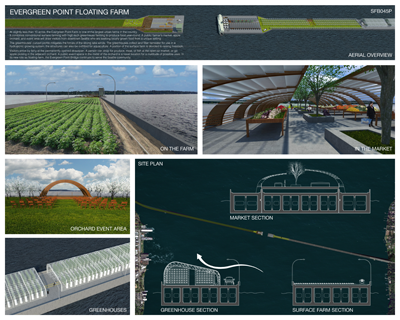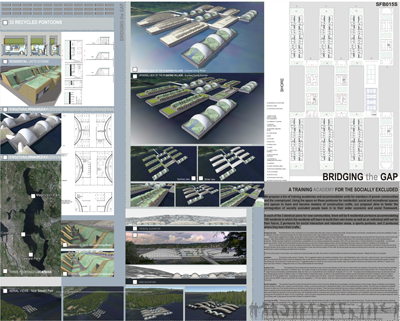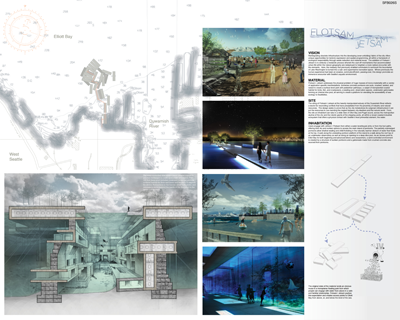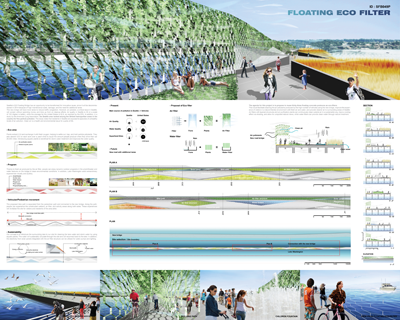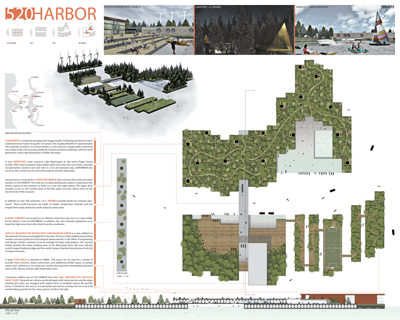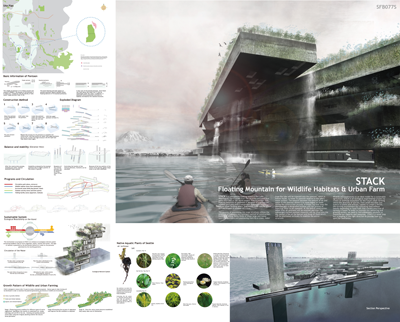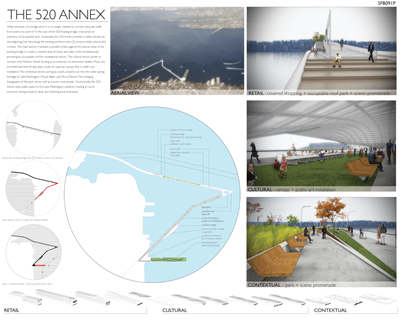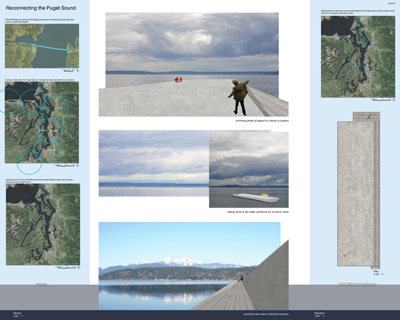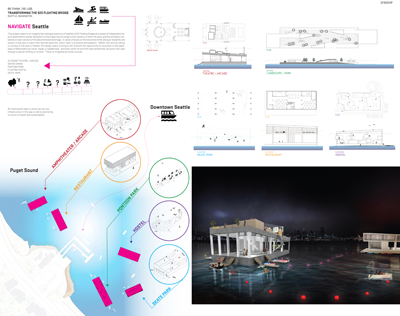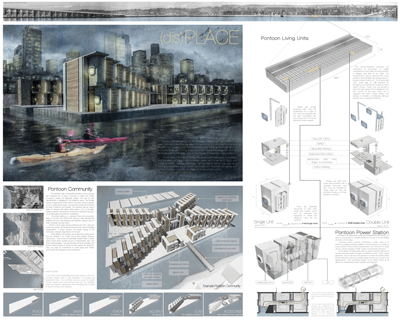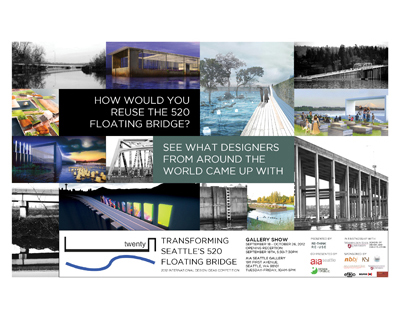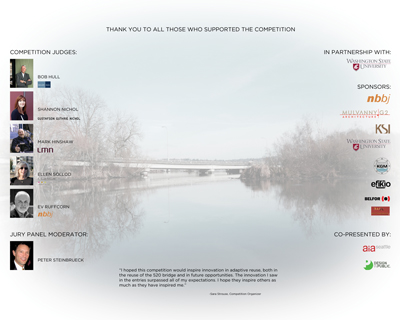A series of site specific island installations that allow for a variety of programmatic responses to the unusual, multi-faceted site of the floating pontoon. Over time the islands return to dock alongside a linear park.
![]()
- FAQ
- DOWNLOADS
- REGISTER
- SPONSORS
- EXHIBITION
- JURY
- SUBMITTAL
- AWARDS
- SCHEDULE
- CHALLENGE
We will be accepting Inquries from June 5 - July 20, 2012. All questions should be sent to inquiries@rethinkreuse.org. Responses will be provided in the order received. Questions and answers that may be relevant to all participants will be posted on the competition website here.
All provided graphics, drawings and information for the development of the design proposals can be found at the "Download" link. No additional documentation will be provided.
Q: Can any other information be provided with relation to the dimensions and construction of the existing pontoons? Do you have any photos of the interiors of the pontoons?
A: Unfortunately we are unable to provide any information that is not already public. However, as this is a design ideas competition, we are more interested in the creativity in the designs than in its feasability.
Q: Do you have any photos of the interiors of the pontoons?
A: No, but video footage of the interiors can be seen in the Travel Channel video link.
Q: Is this competiton open to any professions? limited to a licensed architect or students?
A: The competition is open to both professionals and students of all of the design and art fields. You do not need to have a registered architect on the team. The goal is to reach as broad of an audience as possible, and receive a diverse array of entries.
Q: If participating as a student, could my entry be awarded with the “First Place” prize ($3,000) or could it only achieve the “Best Student Entry” Prize ($500)?
A: Student entries will be available to win all of the awards, however only a student entry may win the "Best Student Entry" award. Be sure and specify that you are a student and what school you are affiliated with in your registration email.
Q: May I email my work to you a day earllier(or days earllier)?
A: You may email your submittal to submit@rethinkreuse.org anytime after you register, but all submittals must be in by midnight, Pacific Standard Time, on August 15th. Entries will be kept confidential until the competition has ended.
Q: Is it possible to provide us with the Seattle city actual plans in .dwg, especially the downtown area?
A: Unfortunately we do not have a set of .dwgs of downtown Seattle. Also, please keep in mind that the parameters of the competition require that the pontoons be used in Lake Washington, Lake Union or the Puget Sound (ie, places where they can be floated to), which means they must remain in the water and should not be relocated to the land.
Q: Is there any graphic information on the way the pontoons are attached to each other and their anchorage system?
A: We do not have information on the connections of the existing plans, however connections for the design of the new bridge are available in pdf format on the downloads page.
Q:From the Google Sketchup model we have measured a standard pontoon to be 242' x 62' x 16', but the literature on the website would suggest these units are 360' x 60' x 14.9'. Which set of dimensions is correct, or is there is more than one size of pontoon?
A: The pontoons vary in size. Some are as long as 360', others are shorter. For the SketchUp file we averaged based on the length of the floating portion of the bridge and the fact that there are 33 pontoons (the size also had to do with making the replicating cavities fit, so they are a little bigger than the actual pontoons, but they're close). You may use either the SketchUp dimensions or the literature for your design purposes, but keep in mind that all 33 pontoons should fit into the 7,578 ft length of the floating portion give or take a little (ie. don't do 33 - 360 ft lengths). Our main concern is the idea behind the design.
DOWNLOADS
Download the complete Competition Brief here.
Download the Competition Poster here.
We have provided a rough section and of the old bridge alongside the new here in AutcoCAD and PDF, along with a rough 3D of a single pontoon in SketchUp withPDF snapshots. Download the zip file here.
The first package of photographs were taken from land and the car. Download the zip file here.
The second package of photographs were taken from the water and have more close-ups. They also show views of the floating pontoons with a raised driving platform. Download the zip file here.
Download a Fact Poster here.
Connections on the NEW BRIDGE can be downloaded here. The existing bridge likely uses a similar system.
HELPFUL LINKS
Travel Channel Tour of Seattle's Floating Bridge - This video has footage of the interior of the pontoons
The competition is open to professionals and students of the international design and art communities over the age of 18. Participants may enter as individuals or in teams of up to four members.
Early Registration: $40 - June 5 to July 5, 2012 (Midnight Pacific-Standard time)
Regular Registration: $100 - July 6 to August 10, 2012 (Midnight Pacific Standard time)
Registrants must email registration@rethinkreuse.org with the name of participant(s), country of citizenship, email, and school/firm associated with (when applicable), as well as the name of the person making the registration payment; registration fees can be done via Paypal (may pay for multiple teams by changing quantity) or Google Accounts. Once the required information and payment have been received, an ID code will be provided for use as identification.
*By registering for the competition entrants commit to having read and agreed to the Terms and Conditions of the Transforming Seattle's 520 Bridge Competition's Legal Policy and Property Rights.
 NBBJ is a global architecture, planning and design firm with offices in the United Kingdom, North America, the Middle East and China. Our approach is based on the belief that design can support and enhance organizational performance. We customize our solutions based on each client’s enterprise, using an engaging process of discovery, design and delivery. NBBJ is a leader in architecture for civic, corporate, commercial, science & education, research, hospitality, retail and sports & entertainment. Other services offered include Change Management, Environmental Graphic Design, Landscape Architecture, Lighting, Retail, Consulting,Sustainability Consulting, Urban and Master Planning and Workplace Strategy.
NBBJ is a global architecture, planning and design firm with offices in the United Kingdom, North America, the Middle East and China. Our approach is based on the belief that design can support and enhance organizational performance. We customize our solutions based on each client’s enterprise, using an engaging process of discovery, design and delivery. NBBJ is a leader in architecture for civic, corporate, commercial, science & education, research, hospitality, retail and sports & entertainment. Other services offered include Change Management, Environmental Graphic Design, Landscape Architecture, Lighting, Retail, Consulting,Sustainability Consulting, Urban and Master Planning and Workplace Strategy.
![]() MulvannyG2 Architecture is the No. 3 retail architect in the worlds and among the largest 50 architecture firms worldwide (BD World Architecture, 2012). We design retail, office, mixed-use, and hospitality facilities for global clients, including five of 2012's top 20 Fortune 500 retailers. Our mixed use developments in expanding and emerging markets, such as the Pacific Rim, have received prestigious design awards.
MulvannyG2 Architecture is the No. 3 retail architect in the worlds and among the largest 50 architecture firms worldwide (BD World Architecture, 2012). We design retail, office, mixed-use, and hospitality facilities for global clients, including five of 2012's top 20 Fortune 500 retailers. Our mixed use developments in expanding and emerging markets, such as the Pacific Rim, have received prestigious design awards.
MulvannyG2 has 300 employees at offices in Bellevue, Wash.; Portland, Ore.; Irvine, Calif.; Washington, D.C.; and Shanghai, China.
 KSI principal William Strouse has been practicing architecture since graduating from Washington State University in 1968. The firm, started in 1978 after teaching at WSU for two years, has focused on retail, office, educational, industrial, multi-family, and single family residential. Through the years KSI has been committed to providing their client with services that explore and develop each project’s potential. From initial meeting and programming through construction documents, construction administration and final turnover, KSI recognizes that each client’s requirements and project goals deserve decisions that provide the most thoughtful and comprehensive long-term solutions.
KSI principal William Strouse has been practicing architecture since graduating from Washington State University in 1968. The firm, started in 1978 after teaching at WSU for two years, has focused on retail, office, educational, industrial, multi-family, and single family residential. Through the years KSI has been committed to providing their client with services that explore and develop each project’s potential. From initial meeting and programming through construction documents, construction administration and final turnover, KSI recognizes that each client’s requirements and project goals deserve decisions that provide the most thoughtful and comprehensive long-term solutions.
KSI clients include Genie Terex AWP, Seattle Music Theatre, Buchanan General, The Little School, Fischer Properties, Radford & Company, AT&T Wireless, Vong’s White Center, Salish Lodge, Boyer’s Children’s Clinic, Friends of Youth, City University, Bellevue Medical Imaging. KSI tenant improvement experience ranges from small to a $22 Million conversion of a B-52 hangar into a modern manufacturing facility for Genie.
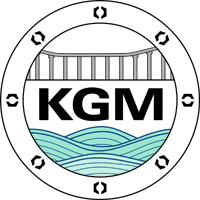 Kiewit/General/Manson a Joint Venture is the contractor awarded the $586.5 million design-build SR520 Floating Bridge and Landings project for WSDOT, continuing a long history of these three companies working together, including significant endeavors such as the San Francisco-Oakland Bay Bridge Skyway contract. The three joint venture partners bring over 325 years of construction experience to the project, and have worked alongside WSDOT for the last 70 years to construct and preserve Washington’s floating bridges.
Kiewit/General/Manson a Joint Venture is the contractor awarded the $586.5 million design-build SR520 Floating Bridge and Landings project for WSDOT, continuing a long history of these three companies working together, including significant endeavors such as the San Francisco-Oakland Bay Bridge Skyway contract. The three joint venture partners bring over 325 years of construction experience to the project, and have worked alongside WSDOT for the last 70 years to construct and preserve Washington’s floating bridges.
The new floating bridge will replace the existing SR 520 Bridge which opened in 1963, and is currently operating over its design capacity. The new bridge is expected to be turned over to traffic by the end of 2014.
This design-build contract includes:
• Building 44 supplemental concrete pontoons and 58 anchors using casting facilities in Port of Tacoma and Kenmore.
• Towing the 33 pontoons built in Grays Harbor, under Kiewit-General’s SR 520 Pontoons contract, and assembling the floating bridge on Lake Washington.
• Constructing a six-lane superstructure on top of the assembled pontoons with wider shoulders, a transit/HOV lane in each direction, and a 14’ bicycle/pedestrian path.
• Building a new maintenance facility and dock on the east shore of Lake Washington to service the bridge.
• Constructing ~1/2 mile of new at grade roadway section.
• Decommissioning the existing bridge through 2015.
 The School of Design and Construction at Washington State University is comprised of professional accredited programs in Architecture, Interior Design, Landscape Architecture and Construction Management. The school was formed in 2011 through the merger of the previous School of Architecture and Construction Management and the Departments of Interior Design and Landscape Architecture.
The School of Design and Construction at Washington State University is comprised of professional accredited programs in Architecture, Interior Design, Landscape Architecture and Construction Management. The school was formed in 2011 through the merger of the previous School of Architecture and Construction Management and the Departments of Interior Design and Landscape Architecture.
The goal of our school is to provide a collaborative educational experience that provides for the highest quality education and engages in innovative and collaborative research that advances the design and construction of the physical environment. The hallmark of our school is that students receive exceptional undergraduate and graduate education while also having opportunities to integrate their education with allied disciplines. With our alliances in Engineering, students in the school have the ability to interact with all disciplines required for the design and construction of the built environment.
Our Graduate programs also emphasize collaboration, as students in each discipline share required coursework and have the opportunity to integrate in teams for their graduate project. All students have access to elective courses in each discipline.
Students also have the opportunity to work with faculty on significant research related to our constructed environment. As an example, students may work with faculty in our Institute for Sustainable Design, as well as take advanced studios in our Integrated Design Experience (IdEX). Graduate students may also partner with professional design firms to create unique research program s that advances the body of knowledge in the professions. Our Integrated Education Symposiums also offer mechanisms for collaboration between students and professionals.
The School of Design and Construction is positioned to provide the next generation of professionals the education required to address the challenges of our built and natural environment. Please feel free to contact us with questions regarding our school and programs.
Sincerely,
Gregory Kessler, AIA, NCARB
Professor and Director
 It's called upcycling and it's where boxes that once shipped auto parts become beautiful shades for pendant lights and worn bike tires become the bags their riders new carry.
It's called upcycling and it's where boxes that once shipped auto parts become beautiful shades for pendant lights and worn bike tires become the bags their riders new carry.
Efikio curates products from designers with an eye toward craft, and connects them with consumers who appreciate the finer things. We also connect those same designers to large manufacturers where the excess materials originate.
In the end, companies reduce their waste, designers get inspired and you get access to goods with a very unique story.
 BELFOR is the leading global restoration and repair company. We analyze and restore fire, water and storm damage of every kind and on any scale. We enable business and private customers to overcome the consequences of damage quickly, smoothly and cost-effectively. We invest every effort in minimizing business interruptions and getting things back to normal. We draw on more than 35 years of experience, use the latest technical equipment and employ highly qualified people. After all, our assignment is more than just a job: the survival of your assets is at stake.
BELFOR is the leading global restoration and repair company. We analyze and restore fire, water and storm damage of every kind and on any scale. We enable business and private customers to overcome the consequences of damage quickly, smoothly and cost-effectively. We invest every effort in minimizing business interruptions and getting things back to normal. We draw on more than 35 years of experience, use the latest technical equipment and employ highly qualified people. After all, our assignment is more than just a job: the survival of your assets is at stake.
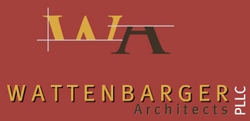 Improving the quality of life for seniors through design.
Improving the quality of life for seniors through design.
Working for non-profit, faith-based providers of housing as well as for-profit developers and operators in senior housing, our design solutions respond to a broad variety of architectural styles, geographic requirements, and operational and management approaches.
The only think that is common between all our designs: putting clients' needs at the center of our solutions.
If you are interested in being a Sponsor of the Competition, send an inquiry email to info@rethinkreuse.org and we will send you Sponsorship Levels and Benefits.
DOWNLOAD LARGE FORMAT PDFS OF ALL THE WINNING ENTRIES HERE
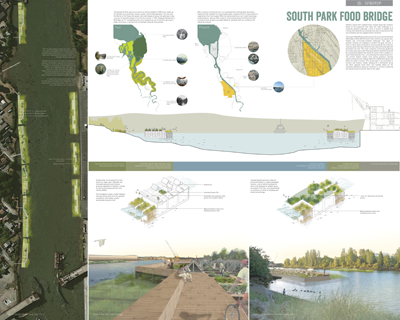
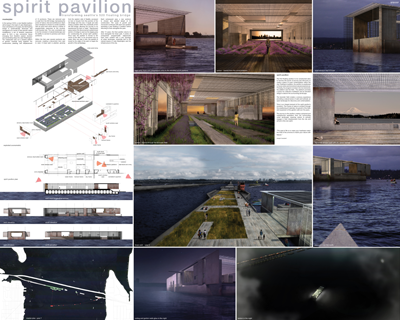
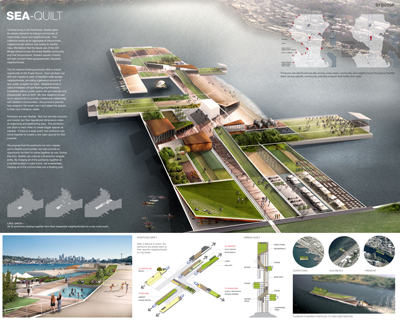
![Cemetery [520]](images/Winning/STUDENT ENTRY.png)
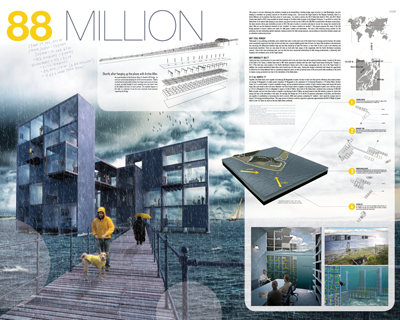
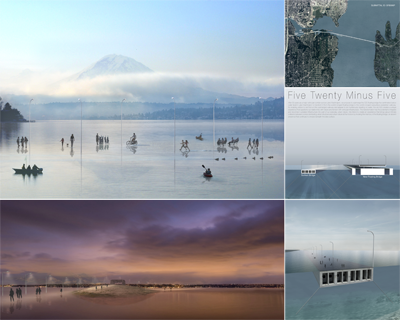
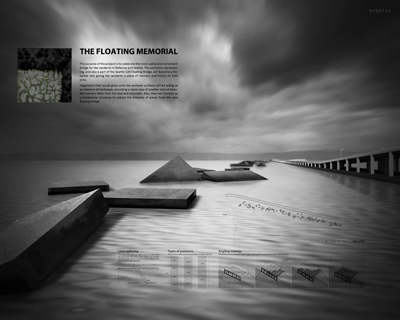
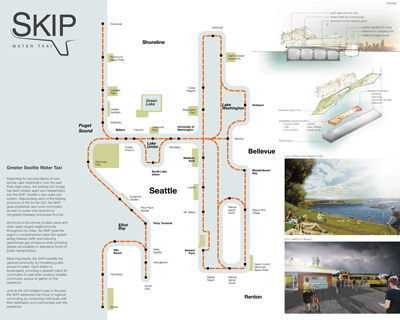
DOWNLOAD LARGE FORMAT PDFS OF ALL THE SHORTLISTED ENTRIES HERE
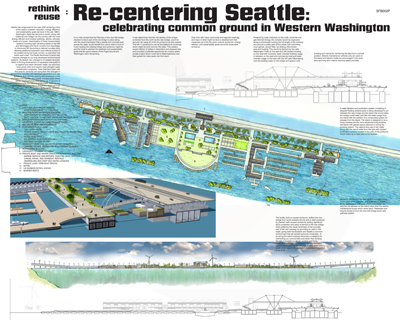
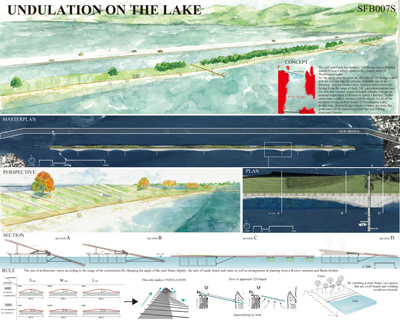
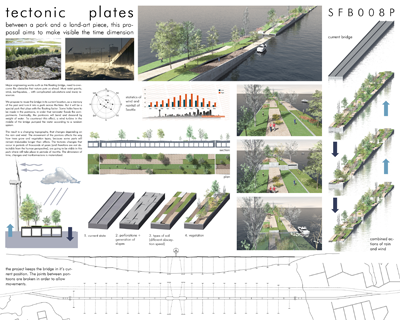
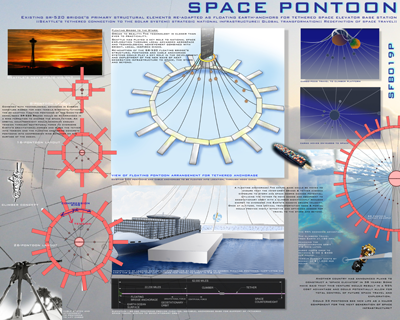
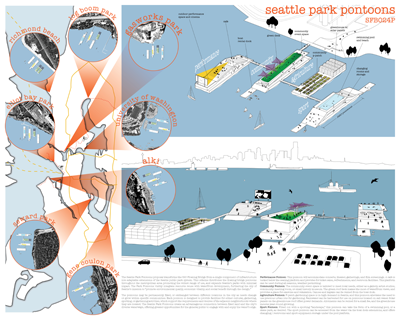
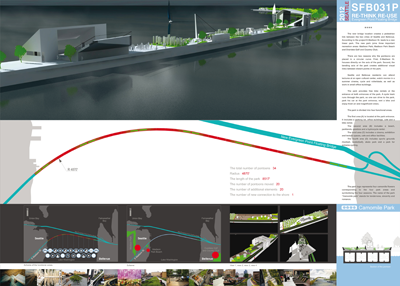
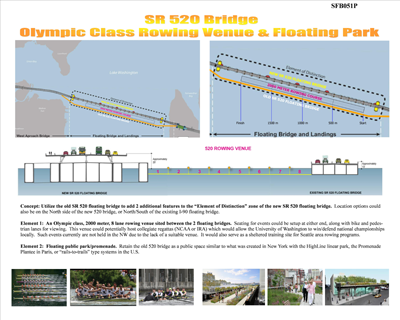
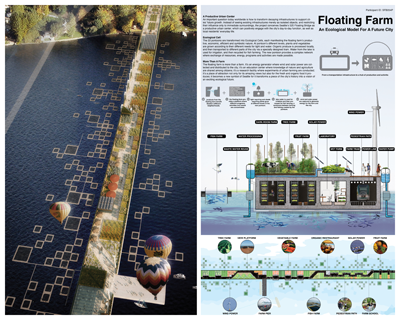
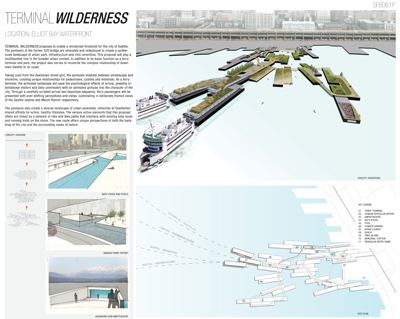
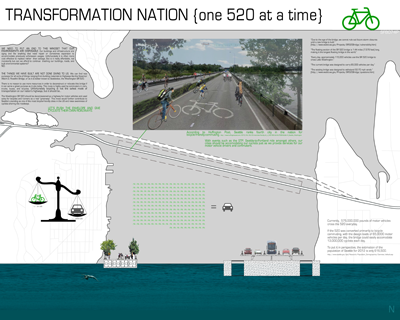
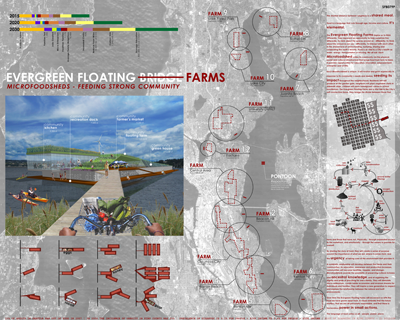
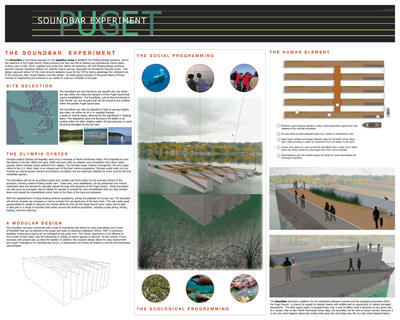
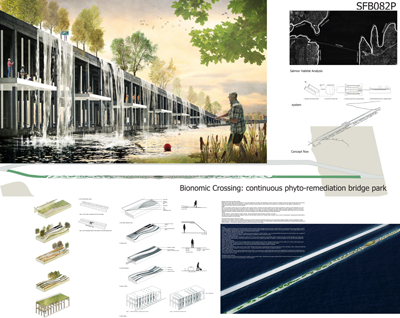
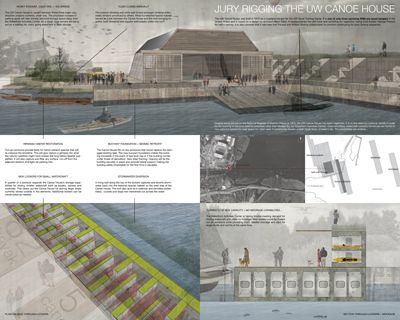
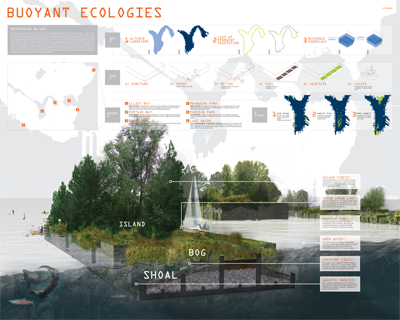
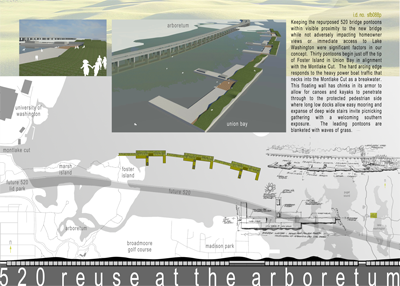
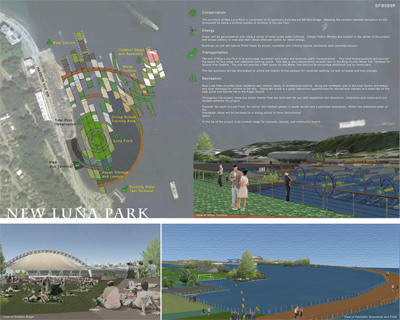
DOWNLOAD LARGE FORMAT PDFS OF ALL THE REMAINING ENTRIES HERE






















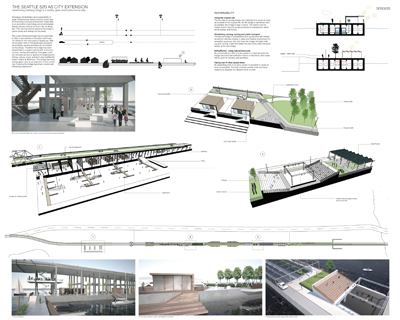

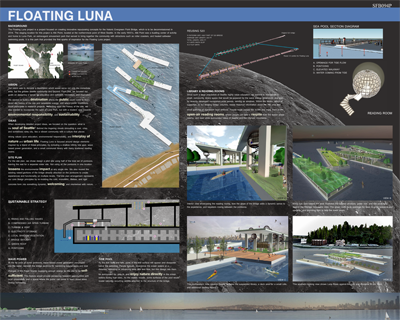
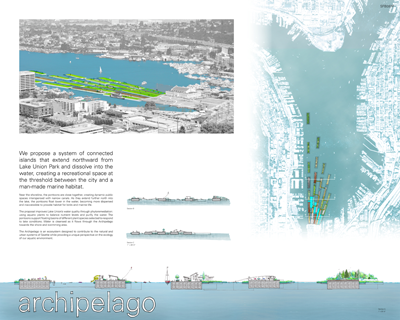
DOWNLOAD LARGE FORMAT PDFS OF THE GALLERY DISPLAY BOARDS HERE

The Seattle AIA welcomed the 520 Competition Entries into their gallery space from September 18 - October 26, 2012. An opening reception on September 18th had an amazing turnout from people from all over the Seattle area interested in the results of the competition.

University of Washington Architecture Graduate Students Kate Murphy and Mazohra Thami volunteered to put together a beautiful spread of food and drinks for the opening reception.
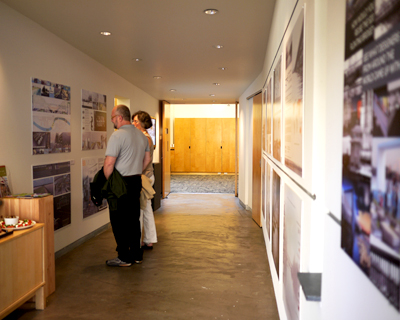
The gallery space before the event began. (See all the boards featured in the event at the end of the slideshow)
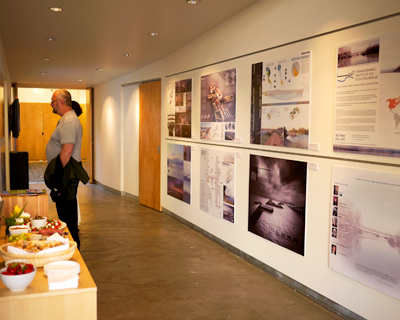
The gallery space before the event began. (See all the boards featured in the event at the end of the slideshow)

Juror Bob Hull from Miller|Hull came to the opening reception to see the final gallery showing and speak with some of the attendees.

Juror Ellen Sollod speaks to Competition Director Sara Strouse in the background while a gallery attendee views a competition entry.

Competition Director Sara Strouse speaking with Gallery Curator friend Kristin Galioto and husband Eric Galioto

The space began to fill up quickly.

A television in the gallery space had a slideshow of all 73 entries running on loop.

David Dahl gets his photo taken next to his submittal. Little did he know that three days later he and his teammate Nicole New would win the first place award for their design "South Park Food Bridge."

Over the course of the two hours of the gallery show, near 100 people came to view the competition entries.
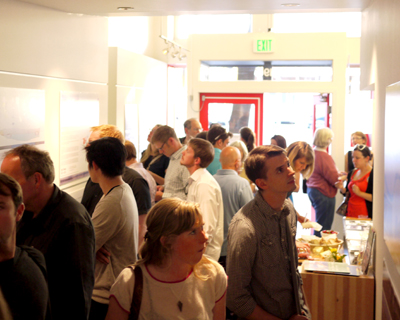
Attendees spent a lot of time reviewing all of the posted entries.

Orlando Orozco, fellow Washington State University graduate architecture student of Sara Strouse, came over from Pullman to support the event..
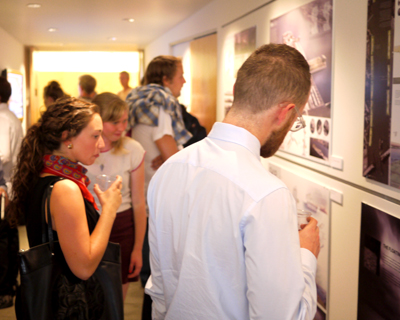
Every entry seemed to have at least one person looking at it all times..
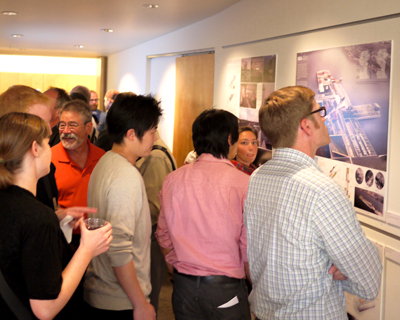
The attendees were constantly talking about how innovative the entries were, there were some great discussions going on all over the room for the full two hours.
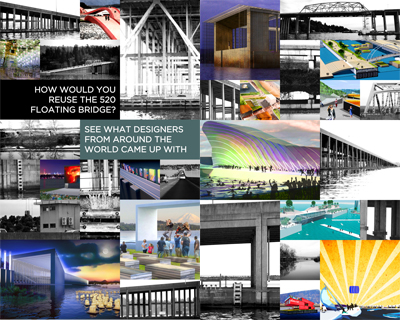
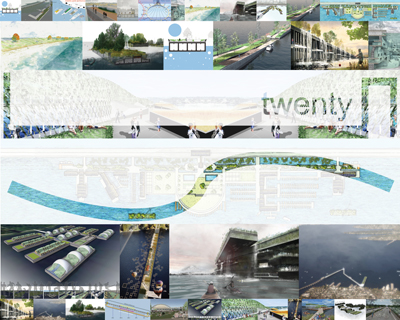
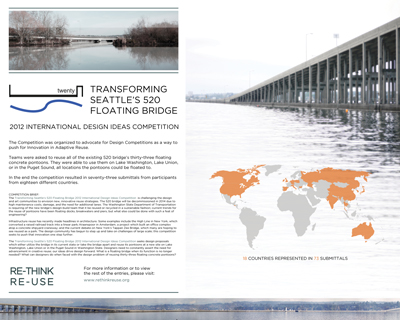



![Cemetery [520]](images/Winning/STUDENT ENTRY.png)




COMING SOON: VIDEO FOOTAGE OF THE JURY PANEL DISCUSSION

The window of the lobby was filled with a single image from all of the 73 submittals received.
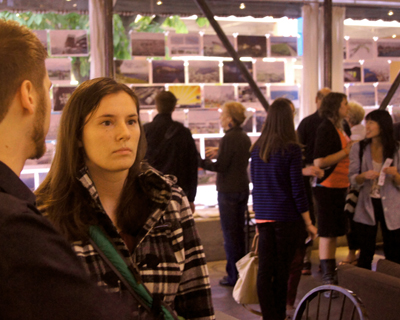
Some of the attendees of the jury panel discussion discussing the competition and admiring the entries before the discussion began
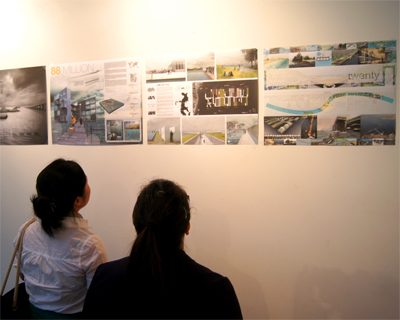
Attendees discussing the top nine entries on the wall, curious as to who won which award.
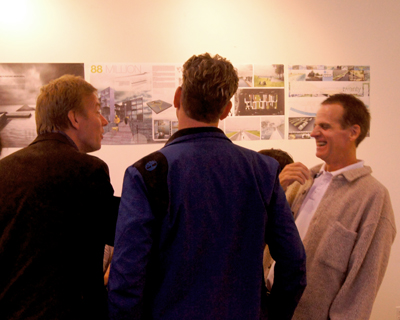
The energy was high in the lobby before the show with the excited attendees engaging about the competition and discussing the night's topic: UpCycling.
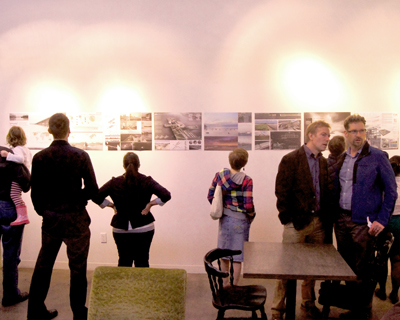
The final gathering of attendees before the beginning of the jury panel discussion. In all, over 100 people attended the event.

Jason Haase of efikio (www.efikio.com) and the Seattle Design Festival's UpCycling event's coordinator introduces the evening events.
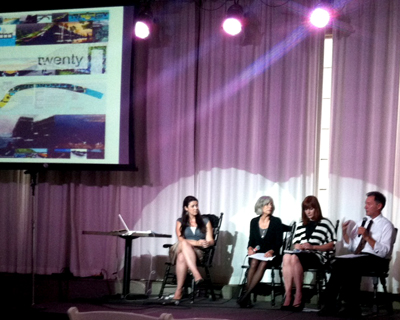
The discussion of the 520 competition begins. From left to right: Sara Strouse, Director of Competition; Ellen Sollod, artist and juror; Shannon Nichol, landscape architect and juror; Peter Steinbrueck, urban strategist and jury panel moderator.
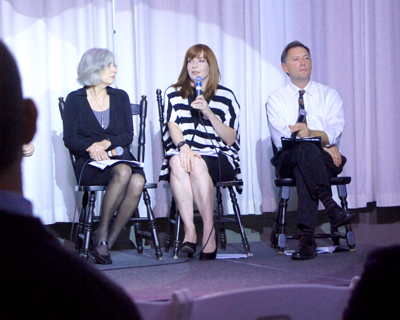
Ellen, Shannon and Peter discussing the entries.
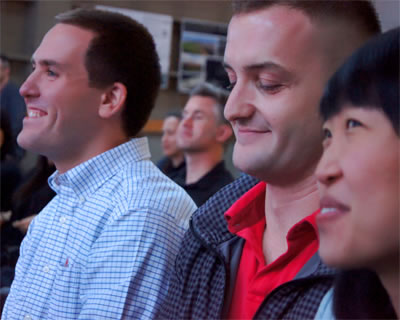
The winning entry team, David Dahl (far left) and Nicole Lew (right), smile as their submittal is announced as having won first place.
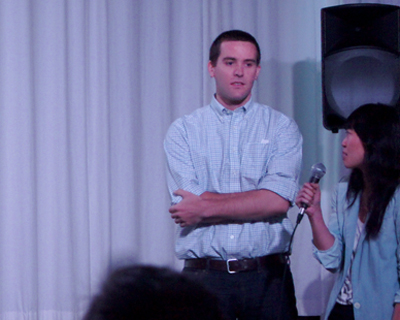
First Place Award "South Park Food Bank" team David Dahl and Nicole Lew come up to the stage to discuss their idea briefly with the panel.
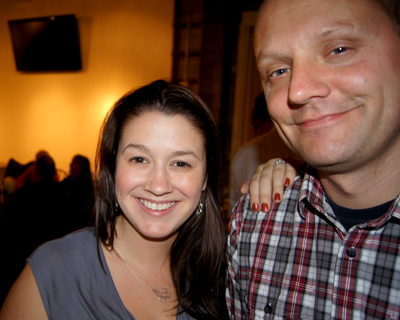
Sara Strouse, Director of the 520 Competition and WSU Architecture graduate student, with Jason Haase, owner of efikio, event organizer, and architect. The two smile for the camera after a very successful event on the topic of UpCycling.
KOMO 4 News did a piece on the competition for the local Seattle news! Watch the clip here.
After attending the Jury Panel Discussion, reporter Scott Gutierrez wrote an article reporting the winning entries. Read it here.
Reporter Jake Ellison from KPLU wrote an article on the competition for the local NRP radio station. Read it here.
The original press release from Washington State University can be read here.
Do you have another story you think people would like to read or see? email it to sara.strouse@rethinkreuse.org and we'll add it to the list!
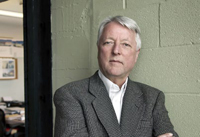 After graduating from Washington State University, Bob's achievements and distinctive design approach began during his four years with the Peace Corps in Afghanistan constructing schools. His work utilized indigenous materials and structures and was influenced by noted modernist architect Louis Kahn while traveling in Bangladesh and India. This work earned him an invitation from Marcel Breuer, in whose New York office Hull's modernist views were further shaped.
After graduating from Washington State University, Bob's achievements and distinctive design approach began during his four years with the Peace Corps in Afghanistan constructing schools. His work utilized indigenous materials and structures and was influenced by noted modernist architect Louis Kahn while traveling in Bangladesh and India. This work earned him an invitation from Marcel Breuer, in whose New York office Hull's modernist views were further shaped.
As a founding partner of The Miller Hull Partnership with David Miller, Bob has been the creative force behind the majority of the firm's higher education and sustainable projects. An award-winning design architect, Bob's design experience on a wide range of project types goes beyond meeting the program requirements: it is a search for ideal solutions. With over 30 years of practice, he has helped foster within his firm an emphasis on creative team design while providing strong inspirational conceptual leadership. Communication skills and ease in the public forum of architecture are recognizable talents that Bob has instilled into the firm practice. These attributes have resulted in design projects that reflect the input of the users in thoughtful and enriched design solutions. Through the leadership of Bob and David, Miller Hull received the National Firm Award from the American Institute of Architects in 2003.![]()
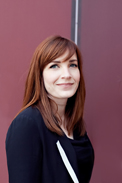 Shannon Nichol is a founding partner of GGN. Her designs, including Millennium Park's Lurie Garden, the Bill & Melinda Gates Foundation Campus, and Boston's North End Parks, are widely recognized for being deeply embedded in their neighborhoods and natural contexts. Shannon's work incorporates complex functions into simple frameworks and refined landforms.
Shannon Nichol is a founding partner of GGN. Her designs, including Millennium Park's Lurie Garden, the Bill & Melinda Gates Foundation Campus, and Boston's North End Parks, are widely recognized for being deeply embedded in their neighborhoods and natural contexts. Shannon's work incorporates complex functions into simple frameworks and refined landforms.
Shannon's current projects include Phase II of the Bill & Melinda Gates Foundation Campus, Rainier Vista at the University of Washington, and plans for Cleveland's historic Group Plan District and Civic Mall - Medical Mart and Convention Center.
Shannon is an honorary member of the American Institute of Architects (Seattle). Her work has received multiple Design Excellence and Honor Awards from ASLA and AIA. Shannon and her partners received the 2011 Cooper- Hewitt National Design Award for Landscape Architecture. Shannon lectures internationally, frequently juries for design awards, and serves on advisory committees for universities and non-profits.![]()
 Ellen Sollod is an environmental artist and designer. She has been practicing the art of making places public for over 15 years. As an artist working in the public realm, she conceptualizes urban spaces as places for people. Adopting a collaborative approach that draws together art with landscape architecture, she creates art for plazas, parks, educational facilities, transit and transportation, and urban infrastructure. Her work speaks to the identity of place and creates intimacy even when the scale is large.
Ellen Sollod is an environmental artist and designer. She has been practicing the art of making places public for over 15 years. As an artist working in the public realm, she conceptualizes urban spaces as places for people. Adopting a collaborative approach that draws together art with landscape architecture, she creates art for plazas, parks, educational facilities, transit and transportation, and urban infrastructure. Her work speaks to the identity of place and creates intimacy even when the scale is large.
With a M.A. in Urban Studies and a B.A. in art history, Ellen brings a broad perspective to her work. She is interested in creating a balance between broad concepts and the particular–through art that brings excitement to the urban environment while revealing little known facts or the hidden histories, creating layers of meaning. She has created works throughout the Pacific Northwest and California. Recent projects include the entry plaza to Bellingham's Arts District (in collaboration with Nakano Associates), Burien Town Square Park (in collaboration with GGLO), and the Olympia,WA Gateway Corridor. She has recently completed work for the Brightwater Wastewater Treatment Plant and is creating art for the Mercer Street Corridor in Seattle.
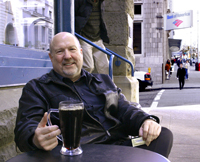 Mark Hinshaw is the Director of Urban Design for LMN Architects, a 100-person firm based in Seattle. For over 30 years he has been responsible for a wide range of projects in both large cities and small towns including downtown development, public spaces and pedestrian facilities, design-oriented codes and guidelines, and master plans for public facilities. He has served as President of the Washington Chapter of the American Planning Association and as President of the Seattle Chapter of the American Institute of Architects.
Mark Hinshaw is the Director of Urban Design for LMN Architects, a 100-person firm based in Seattle. For over 30 years he has been responsible for a wide range of projects in both large cities and small towns including downtown development, public spaces and pedestrian facilities, design-oriented codes and guidelines, and master plans for public facilities. He has served as President of the Washington Chapter of the American Planning Association and as President of the Seattle Chapter of the American Institute of Architects.
Mark Hinshaw has extensive experience in community planning and urban design. He combines his education and earlier experience as an architect to his later education and experience as a city planner to help advise communities on the connections between public policy, public investments, regulations and procedures. He has been influential in the development of urban centers throughout the Puget Sound metropolitan area such as Bellevue, Tacoma, Bremerton, Redmond, Issaquah, Bainbridge Island, Edmonds, Lynnwood, Auburn, Kent, and Mercer Island -- all of which have had transit as a key element. During the 1980's he served as Principal Urban Designer for the City of Bellevue and was chiefly responsible for putting in place codes, design guidelines, streetscape and strategic public projects and public spaces which have led to that city becoming a national model for transforming suburban agglomerations into mixed use urban centers. Since then he has worked with many other cities elsewhere in the country in which the linkage between land use and transportation was key. He has also authored three books on urban development.![]()
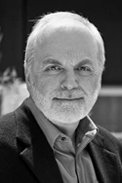 Ev Ruffcorn has applied the art of architecture and community building, with patience and tenacity, to attain not only design excellence, but also the completion of numerous influential and award-winning buildings. The fundamental premise that unites all of Ev’s work is that his buildings represents the intrinsic values of the people who occupy them, the institutions they symbolize and the communities of which they become a part.
Ev Ruffcorn has applied the art of architecture and community building, with patience and tenacity, to attain not only design excellence, but also the completion of numerous influential and award-winning buildings. The fundamental premise that unites all of Ev’s work is that his buildings represents the intrinsic values of the people who occupy them, the institutions they symbolize and the communities of which they become a part.
Ev has more than forty years of experience as a principal designer and before joining NBBJ as a Principal Designer, he was the founding partner of ruffcorn mott hinthorne stine and partner-in- charge of design at the Seattle office of the nationally commended firm Zimmer Gunsul Frasca Partnership. Although Ev has designed a wide variety of project types, he has focused the majority of his professional career in designing buildings for public and academic clients across the country.
Ev is a graduate of Washington State University and he currently serves as a Member of the Advisory Board for the WSU School of Design and Construction. His contributions to the profession include service on many AIA chapter and regional design awards juries and selection committees for public artists; a member of the American Institute of Architects Committee on Design and is a Fellow in the American Institute of Architects. He has also been a visiting professor and critic in design at the University of Oregon, Oregon School of Design, Washington State University, and University of Washington; and past President of the Seattle Architectural Foundation.![]()
 Peter Steinbrueck, FAIA is an architect, design strategist, and founding principal of Steinbrueck Urban Strategies, LLC. His clients have included mission-driven organizations, institutions, and municipalities concerned with optimizing urban infrastructure, urban design excellence and master planning of campus facilities. As a former three-term Seattle city council member from 1997 to 2007, Steinbrueck led numerous legislative efforts in to advance cutting edge urban policies in land use and development, energy, waste, water resource, transportation, parks, affordable housing, and ending homelessness,. Steinbrueck has been a visiting instructor at the University of Washington’s College of the Built Environments, and is a frequent speaker, writer, and thought leader on an emerging Framework for Advancing Sustainable Cities in the U.S and globally. In 2010, Steinbrueck was a Harvard Loeb Fellow, where his research focused on urban environmental policy in the U.S. He is a Core Member of the Harvard Working Group for Sustainable Cities, serves on the U.S. Congress Livable Communities Advisory Board, and is a founding member of the AIA Center for Civic Leadership. A Seattle native, Peter is proud father to two teenage boys, Mason and Ben.
Peter Steinbrueck, FAIA is an architect, design strategist, and founding principal of Steinbrueck Urban Strategies, LLC. His clients have included mission-driven organizations, institutions, and municipalities concerned with optimizing urban infrastructure, urban design excellence and master planning of campus facilities. As a former three-term Seattle city council member from 1997 to 2007, Steinbrueck led numerous legislative efforts in to advance cutting edge urban policies in land use and development, energy, waste, water resource, transportation, parks, affordable housing, and ending homelessness,. Steinbrueck has been a visiting instructor at the University of Washington’s College of the Built Environments, and is a frequent speaker, writer, and thought leader on an emerging Framework for Advancing Sustainable Cities in the U.S and globally. In 2010, Steinbrueck was a Harvard Loeb Fellow, where his research focused on urban environmental policy in the U.S. He is a Core Member of the Harvard Working Group for Sustainable Cities, serves on the U.S. Congress Livable Communities Advisory Board, and is a founding member of the AIA Center for Civic Leadership. A Seattle native, Peter is proud father to two teenage boys, Mason and Ben.
The final proposal must be submitted as a digital jpeg document sized to print as a 32" x 40" board of landscape orientation (horizontal). In the upper right-hand corner the participants must include their ID code; no other personal or professional information will be allowed on the proposal to insure anonymity in judging. A second jpeg able to print at 11" x 17" of a single rendering also visible on the board must also be submitted, this image will be used for any publicity or publication. The submittal should include:
Participant ID Code in upper right-hand corner
Title of proposal
Site location selected
Plan(s), elevation(s) and section(s) that explain the character of the proposal
Perspectives: computer rendered, hand drawn, or photographs of physical model
Brief written explanation of project
Any additional material deemed necessary by the entrant to explain the design
All text included must be in English.
The final proposal must be uploaded and submitted by 11:59 pm Pacific Standard Time on August 15, 2012 to submit@rethinkreuse.org.
Email attachments may not exceed 25 MB.
The Transforming Seattle's 520 Floating Bridge 2012 International Design Ideas Competition will be awarding a total of $6,000 in cash prizes.* Each submittal is only eligible for one award.
First Place - $3,000
Second Place - $1,500
Third Place - $500
Best Student Entry - $500
5 Honorable Mentions - $100 each
The Competition has no authority to award a design contract for this project. It is an ideas competition with the intent only to promote innovation and discussion. The competition is in no way linked to the Washington State Department of Transportation or any other controlling government agency.
*Awards will be provided via a check from Washington State University. Winners will be required to provide further information before receiving their awards. International winners will be subject to US taxes before their award will be released
June 5, 2012 Competition Announcement; Early Registration Begins; Inquiry Period Begins
July 5, 2012 End of Early Registration
July 20, 2012 Inquiry Deadline
August 10, 2012 Registration Closes
August 15, 2012 Submissions Due
September 21, 2012 Awards Announced at Seattle Design Festival and on Website
Sept. 18 - Oct. 26, 2012 Public Exhibition in AIA Seattle Gallery; Virtual Exhibition launched during this time
 The Transforming Seattle's 520 Floating Bridge 2012 International Design Ideas Competition is challenging the design and art communities to envision new, innovative reuse strategies. The 520 bridge will be decommissioned in 2014 due to high maintenance costs, damage, and the need for additional lanes. The Washington State Department of Transportation is requiring of the new bridge's design-build team that it be reused or recycled in a sustainable fashion; current trends for the reuse of pontoons have been floating docks, breakwaters and piers, but what else could be done with such a feat of engineering?
The Transforming Seattle's 520 Floating Bridge 2012 International Design Ideas Competition is challenging the design and art communities to envision new, innovative reuse strategies. The 520 bridge will be decommissioned in 2014 due to high maintenance costs, damage, and the need for additional lanes. The Washington State Department of Transportation is requiring of the new bridge's design-build team that it be reused or recycled in a sustainable fashion; current trends for the reuse of pontoons have been floating docks, breakwaters and piers, but what else could be done with such a feat of engineering?
Infrastructure reuse has recently made headlines in architecture. Some examples include the High Line in New York, which converted a raised railroad track into a linear park; Kraanspoor in Amsterdam, a project which built an office complex atop a concrete shipyard craneway; and the current debate on New York's Tappan Zee Bridge, which many are hoping to see reused as a park. The design community has begun to step up and take on challenges of large scale; this competition seeks to push that innovation one step further.
The Transforming Seattle's 520 Floating Bridge 2012 International Design Ideas Competition seeks design proposals which either utilize the bridge in its current state or take the bridge apart and reuse its pontoons at a new site on Lake Washington, Lake Union or in the Puget Sound in Washington State. Designers need to constantly assert the need for advancement in creative reuse; our ideas drive design forward. What is a floating bridge when its function is no longer needed? What can designers do when faced with the design problem of reusing thirty-three floating concrete pontoons?Follow @rethinkreuse
![]()
Download Complete Brief Here. Help spread the word! Download the Competition Poster Here!
![]()
![]()

